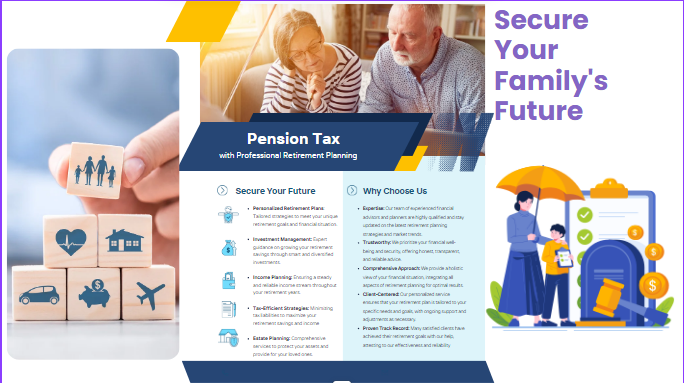Pension Tax:
Planning for retirement involves many factors, and understanding pension tax is a crucial part of this process. For many, pensions represent a vital income source after they stop working. However, knowing how pensions are taxed can help maximize benefits and minimize tax liabilities. In this comprehensive guide, we will explore what pension tax is, how it works, the different types of pensions, tax-free options, and frequently asked questions.
What is Pension Tax?
Pension tax refers to the taxation applied to the income you receive from your after retirement. This tax is usually treated as regular income and is subject to income tax rules in your country. Understanding how works can help you plan your retirement withdrawals more effectively and ensure that you don’t pay more tax than necessary.
How Does Pension Tax Work?
The way pension tax works depends on the type of and the rules in your country. Generally, there are two main stages of pension taxation:
Contribution Stage:
- Contributions to certain types of pensions may be tax-deductible, meaning you won’t pay tax on the money you contribute.
- Some pensions, however, may require after-tax contributions.
Withdrawal Stage:
- Most pension withdrawals are considered taxable income.
- The tax rate depends on your total income during retirement.
Types of Pensions and Their Tax Implications:
Different pension types have distinct tax implications. Understanding these differences can help you make better decisions when saving for retirement.
Defined Benefit Pension (DBP)
- How it Works:
A guaranteed income based on salary and years of service. - Taxation:
Income received is taxable at standard income tax rates.
Defined Contribution Pension (DCP)
- How it Works:
Contributions are invested, and the amount received depends on investment performance. - Taxation:
Withdrawals are taxed as income, but contributions may be tax-deductible.
State Pension
- How it Works:
A government-provided pension based on National Insurance contributions. - Taxation:
Considered taxable income but often below tax thresholds for many retirees.
Private and Personal Pensions
- How it Works:
Individually managed and funded by contributions. - Taxation:
Similar to defined contribution pensions, with taxable withdrawals.
Tax-Free Pension Options
While most withdrawals are taxable, there are ways to minimize or eliminate tax liabilities.
- Tax-Free Lump Sum
- In many countries, retirees can withdraw a portion of their savings tax-free.
- Typically, up to 25% of your pot can be taken as a -free lump sum.
- Roth IRAs and Similar Plans
Contributions are made with after-tax income.
- Withdrawals are tax-free, including investment gains, provided conditions are met.
- ISA Pensions and Similar Accounts
- In the UK, Individual Savings Accounts (ISAs) grow tax-free.
- Withdrawals are also tax-free, making them a valuable supplement to taxable pensions.
How to Reduce Legally
Minimizing can help you retain more of your retirement income. Here are some strategies:
- Use Tax Allowances Efficiently
- Make use of annual tax-free allowances for income and capital gains
- Distribute withdrawals to stay below higher tax bands.
- Pension Income Splitting
- If married, consider splitting pension income to lower tax rates.
- This strategy takes advantage of lower tax brackets available to each spouse.
- Timing Withdrawals Smartly
- Delay withdrawals to reduce taxable income in high-income years.
- Consider spreading withdrawals over several years to stay in lower tax brackets.
Read Also : Vintage Car Tax Ireland
Common Mistakes to Avoid with Pension Tax
- Withdrawing Too Much at Once:
Large withdrawals can push you into higher tax brackets. - Ignoring Tax on State Pensions:
State pensions are taxable; plan for this when budgeting retirement income. - Missing Out on Tax-Free Lump Sums:
Not taking advantage of the tax-free portion can lead to higher overall tax liability.
Pension Tax for Expats
If you live abroad, rules can be more complex. Key considerations include:
- Double Taxation Agreements (DTAs):
These agreements prevent paying tax twice on the same income. - Non-Resident Tax Rules:
Some countries tax only domestic income, while others tax worldwide income.
Pension Tax and Inheritance
When planning for your family’s future, consider how pensions are taxed upon death:
- Defined Contribution Pensions:
Usually, can be passed on tax-free if the holder dies before a certain age (often 75). - Defined Benefit Pensions:
May offer reduced benefits to dependents, often taxable.
Future Changes in Pension Tax
Pension tax laws are subject to change. Staying informed about potential reforms can help you adapt your retirement strategy:
- Rising Tax Rates:
Some governments propose higher taxes on pensions to fund public services. - New Allowances and Reliefs:
Potential for increased tax-free allowances for pension withdrawals.
Conclusion
Understanding is essential for effective retirement planning. By knowing how different types of pensions are taxed and utilizing tax-free options and strategies, you can maximize your retirement income. Stay informed about changes in tax laws and consider consulting a financial advisor for personalized advice. With careful planning, you can enjoy a comfortable and tax-efficient retirement.
FAQs:
1. Is my state pension taxable?
Yes, state pensions are considered taxable income, but they may fall below the taxable threshold.
2. How much tax will I pay on my pension?
It depends on your total income and the tax bands in your country. Most pensions are taxed as regular income.
3. Can I withdraw my pension tax-free?
Typically, up to 25% of your pension can be taken as a tax-free lump sum.
4. Are all pensions taxable?
Most are, but some accounts like Roth IRAs offer tax-free withdrawals if conditions are met.
5. How can I reduce my pension tax?
Strategies include tax-free lump sums, efficient use of tax allowances, and timing withdrawals smartly.


